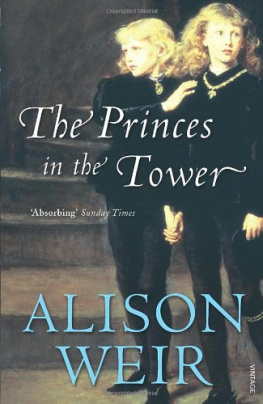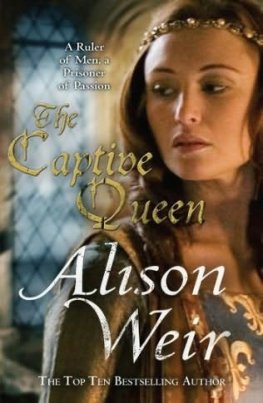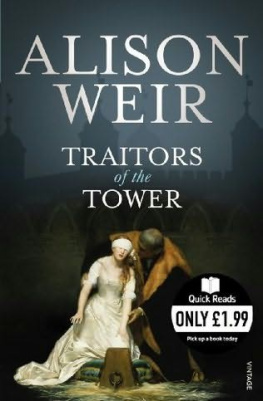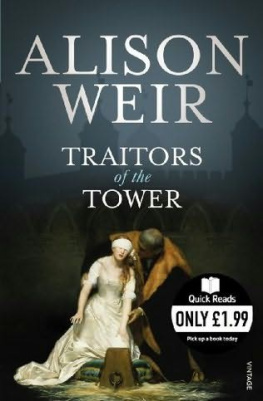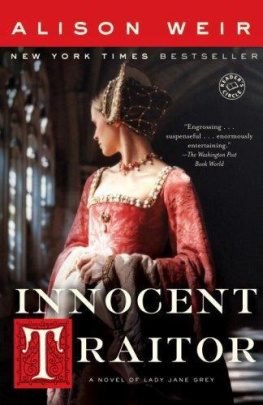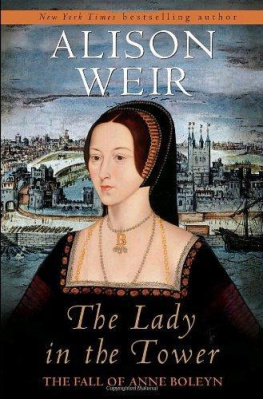Alison Weir - The Princes in the Tower
Here you can read online Alison Weir - The Princes in the Tower full text of the book (entire story) in english for free. Download pdf and epub, get meaning, cover and reviews about this ebook. year: 1995, publisher: Ballantine, genre: Non-fiction. Description of the work, (preface) as well as reviews are available. Best literature library LitArk.com created for fans of good reading and offers a wide selection of genres:
Romance novel
Science fiction
Adventure
Detective
Science
History
Home and family
Prose
Art
Politics
Computer
Non-fiction
Religion
Business
Children
Humor
Choose a favorite category and find really read worthwhile books. Enjoy immersion in the world of imagination, feel the emotions of the characters or learn something new for yourself, make an fascinating discovery.
- Book:The Princes in the Tower
- Author:
- Publisher:Ballantine
- Genre:
- Year:1995
- Rating:5 / 5
- Favourites:Add to favourites
- Your mark:
- 100
- 1
- 2
- 3
- 4
- 5
The Princes in the Tower: summary, description and annotation
We offer to read an annotation, description, summary or preface (depends on what the author of the book "The Princes in the Tower" wrote himself). If you haven't found the necessary information about the book — write in the comments, we will try to find it.
The Princes in the Tower — read online for free the complete book (whole text) full work
Below is the text of the book, divided by pages. System saving the place of the last page read, allows you to conveniently read the book "The Princes in the Tower" online for free, without having to search again every time where you left off. Put a bookmark, and you can go to the page where you finished reading at any time.
Font size:
Interval:
Bookmark:
This book is dedicated to my cousin, Christine Armour,
and in loving memory of Joan Barbara Armour
' ... look back with me unto the Tower.
Pity, you ancient stones, those tender babes,
Whom envy hath immured within your walls!
Rough cradle for such little, pretty ones!
Rude, ragged nurse, old sullen playfellow
For tender princes ... '
Richard III, Act IV, Scene I
'Ah me, I see the ruin of my House!
The tiger now hath seiz'd the gentle hind;
Insulting tyranny begins to jet
Upon the innocent and aweless throne:
Welcome destruction, blood and massacre!
I see, as in a map, the end of all.'
Richard III, Act II, Scene IV
Contents
Author's Preface xiii
1 Richard III and the Chroniclers 1
2 The Sanctuary Child 14
3 Richard of Gloucester 27
4 Clarence and the Wydvilles 37
5 'Deadly Feuds and Factions' 52
6 'Those of the Queen's Blood' 63
7 'An Innocent Lamb in the Hands of Wolves' 77
8 The Lord Protector 87
9 The Fall of Hastings 97
10 'This Act of Usurpation' 109
11 Richard III 128
12 Conspiracies 139
13 The Princes in the Tower 147
14 The Wicked Uncle 163
15 Rebellion 179
16 An Especial Good Lord 191
17 An Incestuous Passion 202
18 A Dark Prince 219
19 Pretenders 231
20 Tyrell's Confession 243
21 The Skeletons in the Tower 249
Genealogical Table: Lancaster and York 259
Select Bibliography 261
Index 273
Illustrations (Removed)
1 Early seventeenth-century (?) copy of a portrait of Richard III. (Courtesy of the Dean and Chapter of Ripon Cathedral)
2 Earliest surviving portrait of Richard, dating from c. 1516-22. (Society of Antiquaries, London)
3 The 'Broken Sword' portrait. (Society of Antiquaries, London)
4 Portrait of Edward IV by an unknown artist, c. 1516-22. (Society of Antiquaries, London)
5 Portrait of Elizabeth Wydville in the North Transept Window at Canterbury Cathedral, probably by William Neve between 1475 and 1483. (Woodmansterne Picture Library)
6 Illustration from The York Roll by John Rous, c. 1483-5. (By permission of the British Library)
7 The Tower of London, from The Poems of Charles of Orleans. (By permission of the British Library)
8 Copy by an unknown artist of a lost portrait of Henry Tudor of c. 1500. (Society of Antiquaries, London)
9 Stained glass window from Little Malvern Priory, Worcester, c. 1481, picturing Elizabeth of York and her sisters.(Matthew Stevens)
10 Portrait by Maynard Waynwyk (working 1509-23) of Margaret Beaufort, Countess of Richmond. (Courtesy of the Marquess of Salisbury)
11 Edward V and Richard, Duke of York, from the North Transept Window at Canterbury Cathedral. (Woodmansterne Picture Library)
12 Hans Holbein's drawing from life of Sir Thomas More, c. 1527. (Windsor Castle Royal Library. 1992 Her Majesty the Queen)
13 Engraving after a painting of the burial of the Princes by James Northcote. (Guildhall Library, Corporation of London)
14 Ruins of the Minoresses' Convent at Aldgate. (By permission of the British Library)
15 Photographs of the remains taken at the time of their exhumation in 1933
16 The urn in which the bones repose. (Courtesy of the Dean and Chapter of Westminster)
17 The skull of Anne Mowbray. (Hulton Picture Co.)
Author's Preface
This is a book about the deaths, in tragic circumstances, of two children. It is a tale so rich in drama, intrigue, treason, plots, counterplots, judicial violence, scandal and infanticide, that for more than five centuries it has been recounted and re-interpreted in different ways by dozens of writers. And it is easy to see why: it is a mystery, a moral tale, and -- above all -- a gripping story. More compellingly, it is the story of a crime that has never been satisfactorily solved.
There are few people who have not heard of the Princes in the Tower, just as there are few people who do not relish a good murder or mystery story. In the case of the Princes, we have an especially fascinating mystery, not only because they were royal victims who lived in a particularly colourful age, nor because there are plenty of clues as to their fate, but because speculation as to what happened to them has provoked controversy for so many hundreds of years. Even today, the battle still rages between those who believe that the Princes were murdered by their uncle, Richard III, and the revisionists, who have forwarded several attractive theories to the contrary.
It has to be said, at the outset, that it is unlikely that the truth of the matter will ever be confirmed by better evidence than we already have. We are talking about a murder that was committed in the strictest secrecy half a millennium ago in a period for which sources are scanty and often evasive. It is true that documents occasionally come to light which add yet another tiny piece to this extremely complex jigsaw-puzzle, but a historian can rarely hope to produce, in such a case, the kind of evidence that would convince a modern court of law of the identity of the murderer. The historian's job is to weigh the evidence available, however slender and circumstantial, and then -- on a balance of probabilities -- reconstruct what probably happened. Thus are history books written, and we should not hope for anything better.
For three centuries and more, the revisionist view of Richard III has prevailed, and in recent years the efforts of the Richard III Society have ensured that textbooks are now being cautiously rewritten to present a kinder view of the last Plantagenet king. Yet since the discovery in 1934 of Dominic Mancini's contemporary account of Richard Ill's usurpation, which corroborated many details in the Croyland Chronicle and other contemporary works hostile to Richard, the majority of serious historians have rejected the revisionist view and stressed the huge amount of circumstantial and other evidence against Richard III.
I have therefore tried to approach this book with as open a mind as possible. I have studied all the contemporary works on the subject, as well as dozens of modern ones, and I have collated all the evidence available. I am now confident that the solution to the mystery presented here is the only plausible one. In my research, I have analysed every sentence written about the disappearance of the Princes in original sources, even rearranging information into its correct chronological sequence, and I have found -- somewhat to my surprise -- that it is indeed possible to reconstruct the whole chain of events leading up to the murder of the Princes, and to show, within the constraints mentioned above, how, when, where, and by whose order, they died. The truth of the matter is there in the sources, for those who look carefully enough. We are dealing here with facts, not just speculation or theories, which I have tried very hard to avoid.
I realise, of course, that my claims are highly contentious, but I am confident that they can be substantiated by good evidence, as I will demonstrate in the text. Thus I hope to entertain, inform, and convince all those who read this book.
Alison Weir
Acknowledgements
I should like to acknowledge my gratitude to the following: Pamela Tudor-Craig (Lady Wedgwood) for permission to use material from her splendid and informative catalogue for the National Portrait Gallery's 1973 exhibition on Richard III; Mr Brian Spencer, for allowing me to use information printed in that catalogue and deriving from his unpublished manuscript about the inmates of the Minories: the Archaeological Resource Centre in York for allowing me to use the services of their textiles expert.
I should also like to acknowledge my indebtedness to the works of the late Professor Charles Ross and that of Mr Desmond Seward, which were a constant inspiration. I must also express my gratitude to my editor, Jill Black, for her constant encouragement and for some extremely helpful suggestions on chronology and dates, especially in relation to Gloucester's coup of April 1483. Gratitude is also due to my agent, Julian Alexander, for his unflagging enthusiasm, and to my husband Rankin and children John and Kate for their forbearance over the last two years.
Next pageFont size:
Interval:
Bookmark:
Similar books «The Princes in the Tower»
Look at similar books to The Princes in the Tower. We have selected literature similar in name and meaning in the hope of providing readers with more options to find new, interesting, not yet read works.
Discussion, reviews of the book The Princes in the Tower and just readers' own opinions. Leave your comments, write what you think about the work, its meaning or the main characters. Specify what exactly you liked and what you didn't like, and why you think so.

